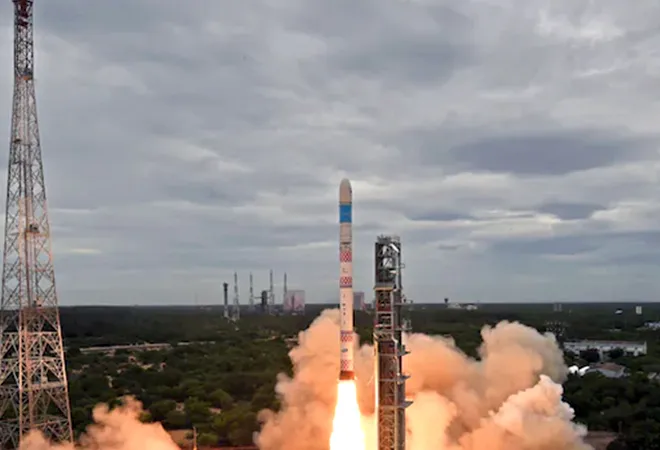On August 7, India launched its newest rocket, the small satellite launch vehicle (SSLV), which unfortunately failed. The launch, which took place from the Satish Dhawan Space Centre, Sriharikota in the state of Andhra Pradesh in southern India, was carrying two satellites – the Earth observation satellite (EOS-02) and AzaadiSAT. EOS-2 is an optical remote sensing satellite with a high spatial resolution, designed and developed by the Indian Space Research Organization (ISRO) with a key
objective “to realise and fly an experimental imaging satellite with a short turn-around time and to demonstrate launch on demand capability.” The second satellite, AzadiSAT, consisted of an array of 75 tiny payloads, weighing around 50 grams, put together by students, to measure ionizing radiation.
Soon after the launch, ISRO Chairman Dr. S Somanath said that there was a
sensor failure or “
a logic problem in the sensor” which resulted in the placing of the satellites in an elliptical orbit, rather than a circular orbit. Due to this failure, the ISRO stated that the satellites “are no longer usable.” But the ISRO chairman added that except for the sensor failure, there was no other anomaly and that every new element added in the new SSLV performed very well including propulsion stages, overall hardware, its aerodynamic design, the new separation system, new generation and low-cost control electronics, and the entire architecture of the rocket.
The SSLV is four-stage launch vehicle, with the three main stages using solid-fueled rocket engines. Insertion of satellites into the intended orbit is done through a liquid propulsion-based velocity trimming module (VTM).
ISRO is planning the next developmental flight of the SSLV (SSLV-D2) in November this year. Although the rocket failed, that all the new elements in the SSLV performed well is an achievement on its own, considering that this was its maiden launch. As a comparison, note that India’s first polar satellite launch vehicle (
PSLV) flight, PSLV-D1, in 1993 was also a failure but today the PSLV is ISRO’s workhorse launcher.
SSLV has been a much-awaited rocket, capable of launching mini, micro or nano satellites weighing from 10 to 500 kilograms into a 500 kilometer planar orbit, essentially low earth orbit. The
SSLV is four-stage launch vehicle, with the three main stages using solid-fueled rocket engines. Insertion of satellites into the intended orbit is done through a liquid propulsion-based velocity trimming module (VTM). SSLV was conceived as an answer to a large number of small satellites launches that otherwise have to piggyback on larger missions, whereas the
SSLV offers a more efficient
option because of its low cost, low turn-around time, flexibility to accommodate multiple satellites, launch-on-demand feasibility, and minimal launch infrastructure requirements. The SSLV takes just three days and six people to integrate, unlike the PSLVs and other launch vehicles, which can take 70 days and 60 people to put together — a big advantage.
The ISRO views the SSLV as an option not merely for India, but also for rocket-launch customers from across the world. Former ISRO Chairman Dr. K. Sivan earlier
said that “about 15 to 20 SSLVs would be required every year to meet the national demand alone.” India’s production of SSLVs through the New Space India Ltd, the commercial arm of the ISRO, can also boost the role and presence of the private sector in India’s space sector. India already has a consortium of industries working together on the ISRO’s tried and tested launcher, the PSLV. ISRO can possibly replicate the PSLV outsourcing route for the SSLV as well, which can augment India’s overall space competitiveness. The SSLV will add a new capability for fast launches to India’s space program.
India’s production of SSLVs through the New Space India Ltd, the commercial arm of the ISRO, can also boost the role and presence of the private sector in India’s space sector.
The ISRO has had some failures recently, but these are not unusual for a space agency. Every space agency has gone through such phases. Not only that, the ISRO has been working on some fairly complex missions in the last few years, which partly accounts for these failures. There has been significant capability expansion within the ISRO as it gets closer to its Gaganyaan human space mission. Although the ISRO had originally planned to launch the Gaganyaan mission in 2022, to coincide with India’s 75th year of independence, it has now been pushed to 2023 or early 2024.
In fact, the chairman of ISRO in an interview
explained that there are multiple missions yet to be done and only after those flight tests will India’s first human space mission be done. Somnath detailed the different missions, including four abort missions and two GSLV Mark III unmanned flights, before the Gaganyaan mission. The GSLV Mk III rocket is designed for heavy launch duties and is the designated launch vehicle for the Gaganyaan mission.
Despite this and other recent failures, the ISRO appears to be taking a determined but prudent path for the future. Thus, the ISRO leadership has postponed missions such as Gaganyaan rather than risk a failure that will have human, material, and reputational costs. There is little doubt that both at the popular and political levels, the Indian space program retains strong support and national commitment.
This commentary originally appeared in The Diplomat.
The views expressed above belong to the author(s). ORF research and analyses now available on Telegram! Click here to access our curated content — blogs, longforms and interviews.




 PREV
PREV


